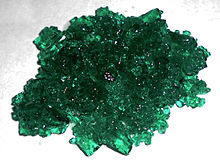Loading AI tools
Chemical compound From Wikipedia, the free encyclopedia
Nickel nitrate is the inorganic compound Ni(NO3)2 or any hydrate thereof. In the hexahydrate, the nitrate anions are not bonded to nickel. Other hydrates have also been reported: Ni(NO3)2.9H2O, Ni(NO3)2.4H2O, and Ni(NO3)2.2H2O.[3]
 | |
 Hexahydrate | |
| Names | |
|---|---|
| IUPAC name
Nickel(II) nitrate | |
| Other names
Nickel nitrate Nickelous nitrate Nitric acid, nickel(2+) salt | |
| Identifiers | |
| |
3D model (JSmol) |
|
| ChemSpider | |
| ECHA InfoCard | 100.032.774 |
| EC Number |
|
PubChem CID |
|
| UNII | |
| UN number | 2725 |
CompTox Dashboard (EPA) |
|
| |
| |
| Properties | |
| Ni(NO3)2 | |
| Molar mass | 182.703 g/mol (anhydrous) 290.79 g/mol (hexahydrate) |
| Appearance | emerald green hygroscopic solid |
| Odor | odorless |
| Density | 2.05 g/cm3 (hexahydrate) |
| Melting point | 56.7 °C (134.1 °F; 329.8 K) (hexahydrate) |
| Boiling point | 120–145 °C (248–293 °F; 393–418 K) (hexahydrate, decomposes to basic nickel nitrate)[1] |
| 243 (hexahydrate) g/100ml (0 °C)[2] | |
| Solubility | soluble in ethanol |
| +4300.0·10−6 cm3/mol (+6 H2O) | |
Refractive index (nD) |
1.422 (hexahydrate) |
| Structure | |
| monoclinic (hexahydrate) | |
| Hazards | |
| GHS labelling: | |
     | |
| Danger | |
| H272, H302, H315, H317, H318, H332, H334, H341, H350, H360, H372, H410 | |
| P201, P202, P210, P220, P221, P260, P261, P264, P270, P271, P272, P273, P280, P281, P285, P301+P312, P302+P352, P304+P312, P304+P340, P304+P341, P305+P351+P338, P308+P313, P310, P312, P314, P321, P330, P332+P313, P333+P313, P342+P311, P362, P363, P370+P378, P391, P405, P501 | |
| NFPA 704 (fire diamond) | |
| Flash point | Non-flammable |
| Lethal dose or concentration (LD, LC): | |
LD50 (median dose) |
1620 mg/kg (oral, rat) |
| Safety data sheet (SDS) | External MSDS |
| Related compounds | |
Other anions |
Nickel(II) sulfate Nickel(II) chloride |
Other cations |
Palladium(II) nitrate |
Related compounds |
Cobalt(II) nitrate Copper(II) nitrate |
Except where otherwise noted, data are given for materials in their standard state (at 25 °C [77 °F], 100 kPa).
| |
It is prepared by the reaction of nickel oxide with nitric acid:
The anhydrous nickel nitrate is typically not prepared by heating the hydrates. Rather it is generated by the reaction of hydrates with dinitrogen pentoxide or of nickel carbonyl with dinitrogen tetroxide:[3]
The hydrated nitrate is often used as a precursor to supported nickel catalysts.[3]
Nickel(II) compounds with oxygenated ligands often feature octahedral coordination geometry. Two polymorphs of the tetrahydrate Ni(NO3)2.4H2O have been crystallized. In one the monodentate nitrate ligands are trans[4] while in the other they are cis.[5]
Nickel(II) nitrate is primarily used in electrotyping and electroplating of metallic nickel.
In heterogeneous catalysis, nickel(II) nitrate is used to impregnate alumina. Pyrolysis of the resulting material gives forms of Raney nickel and Urushibara nickel.[6] In homogeneous catalysis, the hexahydrate is a precatalyst for cross coupling reactions.[7]
Seamless Wikipedia browsing. On steroids.
Every time you click a link to Wikipedia, Wiktionary or Wikiquote in your browser's search results, it will show the modern Wikiwand interface.
Wikiwand extension is a five stars, simple, with minimum permission required to keep your browsing private, safe and transparent.